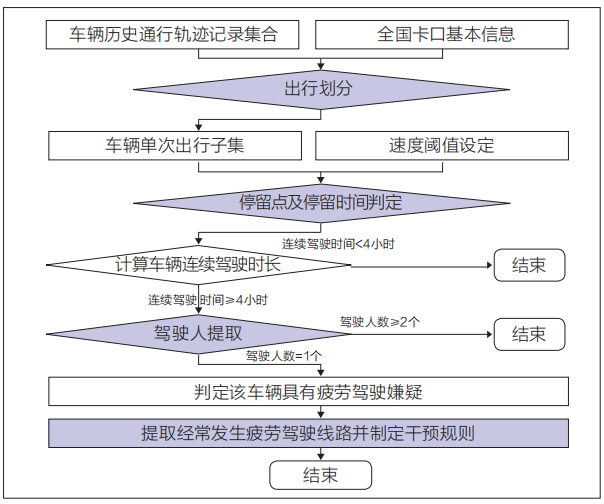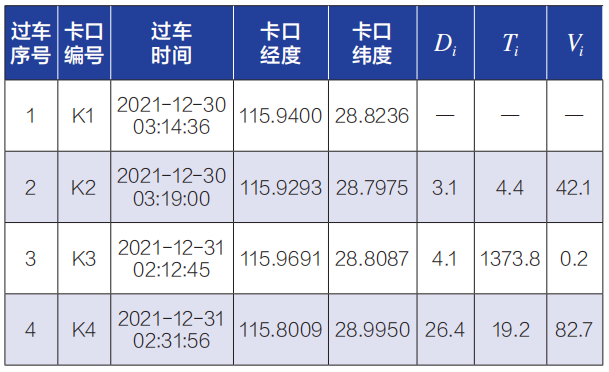Study on the analysis algorithm of fatigue driving vehicles based on the trajectory of the mounting trajectory
Author:Road Traffic Management Magazi Time:2022.07.08


Guide
Fatigue driving is a serious traffic violation. The public security traffic management department usually prevent fatigue driving from time to time. Given that there are a large number of road bayonet monitoring equipment in the national main roads, the traffic integration command platform formed by the Internet has accumulated a large amount of motor vehicle trajectory data. The robustness of the algorithm is verified by instances, which is of great significance for the hidden danger of eliminating fatigue driving risks in a timely manner.

Picture/Yang Lin
Fatigue driving is one of the important reasons for causing major road traffic accidents. How to effectively monitor the fatigue state of motor vehicle drivers has always attracted much attention from all walks of life. Strengthening the investigation of fatigue driving vehicles is the consensus of the whole society. At present, the research on fatigue driving is mainly concentrated in the monitoring of the physiological characteristics of motor vehicles, driver behavior and facial feature monitoring, and vehicle behavior characteristics monitoring. Most of the research results rely on additional vehicle devices for data collection. The applied algorithms and analysis methods have high quality requirements for vehicle -related data, images and other information; but in the actual scenario Information acquisition is not only difficult, but also is not conducive to the integration application of the public security traffic management department.
Therefore, in order to actively discover fatigue driving vehicles, this article is based on Article 62) of the "Regulations on the Implementation of the Road Traffic Safety Law of the People's Republic of China": "Driving motor vehicles must not drive a motor vehicle for more than 4 hours without parking or parking or parking The rest time is less than 20 minutes ", and proposes the analysis algorithm of fatigue driving vehicle based on road mount monitoring equipment to record the trajectory of the driving trajectory. It can effectively judge illegal driving of vehicles and conducts advance intervention of vehicles that are about to occur, thereby reducing traffic accidents that occur due to fatigue driving.
01
general idea
The road bayonet monitoring equipment is an intelligent monitoring record device set up along the road and urban roads. It can record vehicles passing by the monitoring area in uninterrupted real -time real -time reality. The collection information includes vehicle serial numbers, number plate types, number plate numbers, vehicles crossing the car, crossing the vehicle over the car Time, bayonet number, etc. Since 2010, road bayonet monitoring equipment has been built on the national main highway, and a traffic integration command platform has been formulated. To this end, the overall framework of the fatigue driving vehicle analysis algorithm based on the mounting trajectory is shown in Figure 1.
Among them, the first is to extract the historical traffic record of the target vehicle from the national motor vehicle driving trajectory library, calculate the pass parameters between adjacent trajectories, and divide the traffic records into several departure sets according to the rules of travel division; the second is to extract in order in turn The vehicle's single travel set, set the speed or travel time threshold to determine the stay and stay time of each travel time; the third is to calculate the continuous driving time of the vehicle's single travel. The car picture and the driver's face recognition, according to the driver's data, finally determine whether the vehicle is suspected of fatigue driving; the fourth is to extract all the sidewalks of driving suspicion of driving, extract the high incidence point of frequent fatigue driving routes and fatigue driving violations. Position, formulate the rules of fatigue driving intervention, and implement warning reminders of suspected fatigue driving vehicles.

Figure 1 overall framework
02
Algorithm implementation
(1) Division of travel
Traveling is the basic unit of vehicle activities. The vehicle traffic record is interrupted and several vehicles include a single travel collection of vehicles that include the starting point trajectory, the trajectory of the trajectory, and the end of the trajectory. The specific travel division method is as follows:
step 1
The target vehicle traffic is extracted. According to the type of number plates and number plate numbers, the historical trajectory of the target vehicle is selected from the national trajectory library, and the time is sorted in the sequence of the vehicle time. If the target vehicle draws the number of trajectories of less than 2 or the first and last trajectory, the interval is less than 4 hours, and the analysis is over; otherwise, turn to step 2.
Step 2
Geographical matching. The basic information table of the passing through the bayonet number is associated with the nation's bayonet to match the stuck, latitude, road code, and road types in the passage trajectory.
Step 3
Pass parameter calculation. Starting from the second trajectory records of the passage of the current trajectory in turn, the straight line distance, time interval TI and average speed VI between the current traffic trajectory and the previous pass trajectory.
The calculation formula of the straight line distance DI is:
Among them, R is the average radius of the earth, taking 6371.004 kilometers; (MLONI, MLATI) and (Mloni-1, MLATI-1) are the strokes of the current traffic trajectory and the previous pass; n is the number of trajectories of the pass; The DI unit is kilometers.
The calculation formula of Ti interval TI is:

(2)
Among them, TI is the passing time of the current trajectory; Ti-1 is the passing time of the previous trajectory; N is the number of traffic trajectory; the TI unit is minutes.
The calculation formula of the average speed VI is:

(3)
Because the distance used in the above formula is a straight line distance, the VI calculation value will be less than the actual average speed.
Step 4
Data processing. There are a large amount of abnormal data in the traffic trajectory data. If the VI exceeds the maximum speed threshold (takes the value according to the actual situation, takes 120km/h in this article), it is considered that the record is recorded as dirty data and eliminated Vi. Step 5
Division of travel. According to the pass parameters, the travel division conditions are set, and the setting conditions for this article are TI ≥ 480 or Ti ≥ 360di ≤ 60VI ≤ 10. If the above conditions are met, it is believed that when the record and the previous record are not belonging to the same travel, the trajectory is interrupted and repeated until all trajectory division ends.
(2) Determination of the stay point and stay time
The vehicle may stop in multiple places during a one -time travel. How to accurately estimate the time for vehicle stay is the key to fatigue driving recognition. The method of determination of specific stays and staying time is as follows:
step 1
Get the reasonable speed threshold between the adjacent card port. First, according to the historical trajectory of the national vehicle history, extract all adjacent mixing pairs, and then count in order to count the travel time distribution of different types of vehicles in order. Finally, the average speed of the average speed is calculated combined with the straight line distance between the bayonet. The %seminars are used as the speed threshold VM that matches the pair.
Step 2
Calculate staying. Extract all the traffic records of the one -time travel of the vehicle. Starting from the second record, calculate the maximum likely to stay between the current record and the previous record in turn. If XI is greater than 10, it is considered that the vehicle has stopped between the current record and the previous record.
The calculation formula of XI for staying time is:
(4)

Among them, n is the number of trajectories of drawing; the XI unit is a minute.
(3) Driver extraction
In the process of judgment of fatigue driving behavior, the vehicle needs to be eliminated with multiple drivers. The specific judgment rules are as follows:
step 1
Calculate the target vehicle continuous driving time. Determine whether the corresponding XI corresponding to the trajectory (2≤i ≤ n) meets the conditions of the rest of the rest of 20 minutes. If xi ≥20, the continuous driving time of the trajectory of the i is li = 0; if i = 2 and xi <20 Then li = ti; if I & 2 and xi <20, then li = li-1+ti, repeat the above steps until the last trajectory. If Max (li) ≤ 240, end analysis; vice versa to step 2.
Step 2
Driving everyone's face recognition. Starting from li = 0, select continuous driving and MAX (Li) & 240 travel section, and pull the car picture for driver's face recognition. First of all, based on the image recognition method, locate the vehicle area and obtain the face area, portrait characteristics, and face area coordinate information of the human face. Save feature data.
Step 3
Defense the suspicion of driving for vehicles. For the characteristic data of the driver's face, the number of travels involves the number of drivers. If the number of drivers is 1, the vehicle does not replace the driver during the travel. There is suspected fatigue driving.
(4) Frequent fatigue driving line extraction
In response to fatigue driving behaviors, there are often laws in time and space. This article uses the PrefixSpan algorithm to dig a sequence mode of fatigue driving trajectory. The specific process is as follows:
step 1
Extract the bayonet sequence. Extract all the suspects of fatigue driving in the target vehicle. From Li = 0, you cut off the travel section of continuous driving and MAX (li) & 240, generate a fatigue driving line stall sequence collection K1; intercept the travel section of Li & 240 to generate fatigue driving driving driving driving Illegal bayonet set K2.
Step 2
Digging frequently. Use the PrefixSPAN algorithm to minimize the sequence set K1, set the minimum length and minimum support of the frequent mode, and obtain the recipient collection of frequent fatigue driving lines.
Step 3
Statistical illegal high incidence points. Statistics Frequent fatigue driving lines appear in the frequency of each bayonet in K2. The frequency threshold M. If the frequency appears more than M, it is considered that the bayonet is considered to be a high incidence of fatigue driving.
Step 4
Formulate intervention rules. Repeat steps 1 to step 3, get the frequent fatigue driving lines of all vehicles and the high incidence of fatigue driving. When the vehicle is detected to enter the frequent fatigue driving route and reach the high incidence of fatigue driving, immediately carry out fatigue driving of the vehicle to driving fatigue driving. Intervention.
03
Instance verification
This article uses the road mounting trajectory data of the road bayonet of the traffic integration command platform to conduct fatigue driving analysis and judgment of a heavy truck from October 2021 to December 2021. Driving across governors, the trajectory involves 7 provinces including Hubei, Jiangxi, Chongqing, Zhejiang, Sichuan, Hunan, and Anhui.
Figure 2 a heavy -duty truck traffic trajectory diagram

Calculate the straight line distance DI, time interval TI and average speed VI in accordance with the formula (1) to formula (3), and according to the rules of TI ≥ 480 or Ti ≥ 360Di ≤ 60VI ≤ 10, Essence Take Table 1 as an example, T3 ≥ 480, so the third trajectory began to travel for a new trip. The final trajectory set was divided into 47 travels.
Table 1 Parameter calculation example
According to the nationwide national heavy truck traffic record in the first week of December, the matching pair of adjacent road bayonets is extracted, and the travel time distribution of the vehicle through the adjacent road bayonet is statistically statistical. Taking the K3-K4 mount as an example, the 95%segmentation of the average speed of the speed is selected as the speed threshold of the matching pair of the road mount, that is, 95.5km/h. According to the formula (4), calculate the maximum of the K3-K4 may stay X4 = 2.6, which is less than 10 minutes. Statistics the maximum continuous driving time for each travel in order, we can see that the car's maximum continuous driving time range, of which the continuous driving time is more than 240 minutes of travel 22 times. The car had 19 times for suspected fatigue driving.

Intercept the fatigue driving line bayonet sequence set K1 and fatigue driving illegal bayonet collection K2, use the PREFIXSPAN algorithm to minimize the sequence set, set the minimum length of the frequency mode to 10, and the minimum support is 0.3. Statistics Frequent the frequency of the roads in K2 in K2 in the regular fatigue driving routes. If the frequency appears more than 3, it is considered that the road bayonet is considered to be a high incidence of fatigue driving illegal acts.
Table 2 Calculation example of frequent fatigue driving line extraction results
The distribution of high incidence points of this heavy truck of fatigue driving lines and fatigue driving behaviors is shown in Figure 3. It can be seen that the vehicle often droves fatigue in the direction of Chongqing in the Lichuan section of the Shanghai -Chongqing highway. Therefore, when the vehicle enters the line and passes through the number of bayonets more than 3, it shall be a warning of its fatigue driving behavior and take subsequent intervention measures.
Figure 3 Frequent fatigue driving lines and fatigue driving illegal high incidence points distribution


- END -
2022 "Fortune" China's Fortune 500 was released, and the ups and downs of various industries in the past 5 years changed

On July 12, the 2022 Fortune China Fortune 500 rankings released by Fortune PLUS A...
With the "small incision" of lychee drive agriculture "big changes", Maoming Litchi Fragrance World

In the cold storage, the workers were busy packaging the last batch of fresh litch...